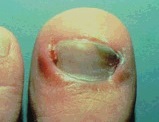
It’s not always possible to prevent toenail fungus, but often it is. As the saying goes, an ounce of prevention is worth a pound of cure, and it’s better to prevent nail fungus than to have to try to treat it. We’ll tell you what you can do, but we’ll also tell you what to do if all your efforts at toenail fungus prevention don’t work and you end up with an infection anyway.
How to Prevent Toenail Fungus
You may be able to prevent nail fungus by taking the following steps:

- Keep your feet clean and dry – make sure to dry thoroughly between your toes, too – and change your socks daily.
- Don’t wear tight hosiery, because that promotes moisture retention and provides an ideal environment for the growth of fungus.
- Wear socks made from materials that wick moisture away from the skin, like nylon, wool, or polypropylene, instead of socks made from cotton, which retain moisture.
- Wear flip flops or shower shoes in locker rooms, public showers, on public pool decks, and at the beach. Those are ideal locations for picking up athlete’s foot as well as toenail fungus.
- Don’t pick at the skin around your nails. Breaks in the skin provide a way for bacteria and fungi to enter your body.
- Keep your nails trimmed. Cut them straight across and just below the tip of your toe. File down any rough or thick edges. If you are diabetic or have difficulty trimming your own toenails for any reason, see a podiatrist regularly to get them trimmed.
- If you get your nails done at a nail salon, make sure all instruments are sterilized between customers. Ask to make sure. Better yet, bring your own. If you get pedicures often, it’s definitely worth investing in your own tools and taking them along to the salon. Make sure to disinfect them between uses.
- Don’t wear nail polish or artificial nails. Nail polish and artificial nails can trap moisture and provide a great environment for fungus to grow(1). If you really want to wear polish for a special occasion, do so but then remove it promptly afterward.
- Get treatment for other fungal infections, like ringworm or athlete’s foot (which is actually ringworm of the foot), promptly, because fungus can spread from other parts of the body to the nails if it isn’t treated. If you have a skin condition of some sort and aren’t sure what it is or how to treat it, see your doctor.
- If you have nail fungus, wash your hands after touching an infected nail to help prevent spreading the infection to other nails.
- Avoid direct physical contact with people or pets that have fungal infections and wash your hands well if you do have physical contact with them.
Talk to your doctor if you need more information about how to prevent toenail fungus.
Treating Toenail Fungus
If you end up with a fungal infection of your nails despite your best efforts at toenail fungus prevention, we recommend getting prompt treatment so the infection doesn’t get worse or spread to other nails. There are prescription drugs available to treat toenail fungus, but many people do fine with over-the-counter treatments. Our favorite treatment for toenail fungus is Funginix, which is available without a prescription. It contains a medication called undecylenic acid that fights fungal infections along with a number of natural ingredients like tea tree oil and lavender oil that also work to cure nail fungus and return nails to a healthy state. If you’ve developed a fungal infection of the nails, we recommend beginning treatment with Funginix right away to prevent the condition from spreading to other nails. For more information about Funginix, just follow the links.
(1) Mayo Clinic: Prevention
